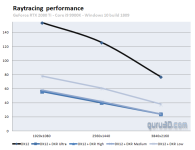Underseer
Contributor
https://www.guru3d.com/news-story/battlefield-v-raytracing-features-are-now-enabled.html
[YOUTUBE]t02BA1wa3qU[/YOUTUBE]
Microsoft's October update got seriously delayed by a bug. Check your Windows computer: it should be bugging you to install the new and improved October update.
Anyway, one of the features of this update is the addition of DXR to DirectX, so now those overpriced RTX cards from nVidia can finally do ray tracing in games. Make that game. Singular. At the moment Battlefield V is the only game that implements ray-tracing and the performance numbers are disappointing to say the least.

The RTX 2080 TI is a $1300+ video card and if you want to do ray tracing in Battlefield V with the highest settings with it, you're looking at framerates that are barely above 20 FPS at a 4K resolution, and doesn't quite hit 60 FPS at HD resolution.
[YOUTUBE]t02BA1wa3qU[/YOUTUBE]
Microsoft's October update got seriously delayed by a bug. Check your Windows computer: it should be bugging you to install the new and improved October update.
Anyway, one of the features of this update is the addition of DXR to DirectX, so now those overpriced RTX cards from nVidia can finally do ray tracing in games. Make that game. Singular. At the moment Battlefield V is the only game that implements ray-tracing and the performance numbers are disappointing to say the least.

The RTX 2080 TI is a $1300+ video card and if you want to do ray tracing in Battlefield V with the highest settings with it, you're looking at framerates that are barely above 20 FPS at a 4K resolution, and doesn't quite hit 60 FPS at HD resolution.
